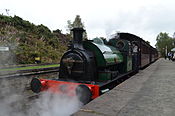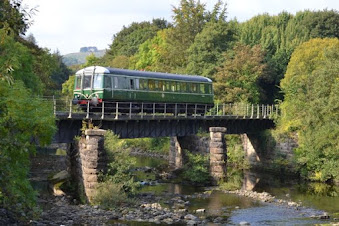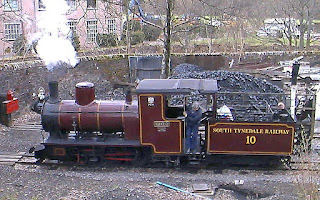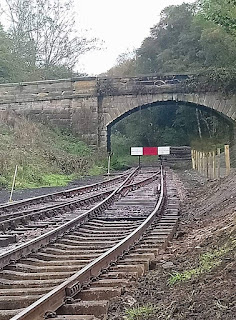While we are continuing to see the easing of the lockdown rules during 2021 we have been looking at a several of the Heritage Railways around Britain. In part one we took a look at some of the relatively local GWR based heritage railways and then we moved a little further down the line for part two towards Bristol and the West where there are several lines which have survived into preservation. Then in part three we headed over the border into Wales to enjoy some of the many 'Great Little Railways of Wales' a second instalment for this is a necessity. Last time for part four of our series ventured over the English border again, this time heading north into Scotland, there we were looking at heritage railways around the Cairngorms region between Inverness and Aberdeen, now for this next chapter in the series we drop back into England and view the northern area of Cumbria and Northumberland.
Weardale Railway
https://www.weardale-railway.com/about/
Tanfield Railway
https://www.tanfield-railway.co.uk/
The Tanfield Railway is a standard gauge heritage railway in Gateshead and County Durham, England. Running on part of a former colliery wooden waggon way, later a steam railway. It operates preserved industrial steam locomotives. The railway operates a passenger service every Sunday, plus other days, as well as occasional demonstration coal, goods and mixed trains. The line runs 3 miles (4.8 km) between a southern terminus at East Tanfield, Durham, to a northern terminus at Sunniside, Gateshead. Another station, Andrews House, is situated near the Marley Hill engine shed. A halt also serves the historic site of the Causey Arch. The railway claims to be "the world's oldest railway". The preserved line was first built from Marley Hill to the current northern terminus, Sunniside Station, with passenger trains beginning on 2 July 1981. Since 2017, the railway has become the home to a large collection of industrial steam engines, with 28 in all, though only three are operational. One is undergoing repairs and three more are under overhaul for future operation, with the other 21 around the Marley Hill site.
Operational steam locomotives
| Number and name | Description | Livery | Owner(s) | Date | Photograph | |
|---|---|---|---|---|---|---|
| Hawthorn Leslie and Company 0-4-0ST, No.2. | Built by Hawthorn Leslie and Company in 1911. Re-entered service after an overhaul in 2013. | A few different shades of green with lining | Tanfield Railway Trust | 1911 |  | |
| 0-4-0ST Sir Cecil A Cochrane | Sir Cecil A Cochrane was built by Robert Stephenson + Hawthorns in 1948 and worked a few miles from its current home. It is currently in regular use on passenger services. | RSH works livery (lined green) | Private | 1948 |  | |
| Andrew Barclay 0-6-0ST No. 1015 "Horden" | This engine was built by Andrew Barclay. The locomotive has been under restoration since August 2012 and is expected to enter service in early 2021. | N/A | Private | 1904 | ||
| 0-6-0T Twizell | Twizell was built by Robert Stephenson and Company in 1891. Currently owned by Beamish Museum, it is currently on long term loan to the Railway. | Black, Lined in Red | Beamish Museum | 1891 |  | |
| Robert Stephenson and Hawthorns 0-6-0ST NCB No. 49 | Built by RSH in 1943. The locomotive returned to service hauling passenger trains in July. | Green with white and black lining | Private | 1943 |  |
Ravenglass & Eskdale Steam Railway
https://ravenglass-railway.co.uk/about-us/
One of the great things to do with all the family is a steam train ride from Ravenglass across seven miles into the heart of the Eskdale Valley and to the foot of Scafell Pike on one of the oldest and longest narrow gauge railways in England. The heritage steam engines transport passengers from Ravenglass, the only coastal village in the Lake District National Park to Dalegarth for Boot that is 210ft above sea level. The journey takes 40 minutes up the line from the protected nature reserve of the Ravenglass Estuary through ancient woodlands and fells of the Eskdale Valley.
South Tynedale Railway
https://www.south-tynedale-railway.org.uk/about-us/
The South Tynedale Railway Preservation Society has run and developed the railway as an incorporated society since 1983, developing the work of an unincorporated group started in 1973. The railway follows the former route of British Rail’s Haltwhistle to Alston branch line. The railway was closed in 1976 and has been partially reopened as a Narrow Gauge line operating over the original route of the former BR line.
A voluntary society was formed to take over the entire route but its initial efforts failed. However, a reformed group successfully opened the first stage of a narrow gauge railway in 1983. Since then the railway has grown and prospered, the South Tynedale Railway heads northwards for almost 5 miles from Alston in Cumbria, past the original terminus at Gilderdale, on through Kirkhaugh and Lintley to the village of Slaggyford. Future plans exist to completely restore the line and reconnect Alston with Haltwhistle.
Negotiations with British Railways Board (Residuary) Ltd. have secured a seven metre wide strip of land at Haltwhistle station following the line of the Alston branch and negotiations with Network Rail to secure access for South Tynedale trains to the one-time bay platform at Haltwhistle are ongoing.Aln Valley Railway
https://www.alnvalleyrailway.co.uk/about-us/the-project
The Alnwick branch line is a partly closed railway line in Northumberland, northern England. A heritage railway operates a short section of the line, which originally ran from Alnmouth railway station, on the East Coast Main Line, to the town of Alnwick, a distance of 2+3⁄4 miles (4.4 km).
The principal objective of the Aln Valley Railway Trust is the restoration and operation of the railway between Alnmouth and Alnwick, providing an additional tourist attraction for the area and to enlarge the district's tourism offering. This project also aims to develop the railway corridor as a sustainable transport link as well as a recreational and educational resource for the local community and visitors to the area. “The Cawledge viaduct is the jewel in the crown of the Aln Valley Railway. It's both an amazing feat of Victorian engineering and a beautiful piece of architecture. Sadly, years of neglect have left it in poor condition. "This project will make sure that it's still there for people to enjoy for the next 100 years.” It is believed to be the country’s oldest, existing heritage railway viaduct. Constructed by the contractors Rush and Lawkin, work started in August 1848 and took almost two years to complete. The viaduct was designed by Robert Stephenson and is built to a similar design as the nearby Lesbury Viaduct, on the Alnmouth to Berwick main line. Due to the building of the A1 bypass which cut the original track bed on the outskirts of the town, and the construction of industrial units and a supermarket on ex-railway land, the costs of getting the line to the original station in Alnwick are almost prohibitive.
A new station has been built on a greenfield site in Lloyd's Field, adjacent to the Lionheart Enterprise Park just outside Alnwick. The new 'Lionheart Station' is aligned parallel to the A1 from where a single track line joins and follows the original track bed towards Alnmouth Station, near Hipsburn. Ultimately heritage steam and diesel locomotives will haul trains between the two locations. As an integral part of the project, a permissive cycle path runs alongside the railway line, and will link up with the National Cycle Network at Alnmouth and the A1068 road next to the A1. This provides a safe corridor for cyclists, pedestrians and riders, and has also been proposed to form the basis for an educational nature trail. The current extent of the line has reached Greenrigg Bridge Halt, and the intention is to continue southwards along the original route to reach Alnmouth and connect with the National Rail network there, a piece of land has been secured at the station making this possible with sufficient funding and goodwill. An important part of the regeneration of any Heritage Railway is that they have plans for future expansion, given they have been going less than twenty years this is an impressive piece of work.








No comments:
Post a Comment